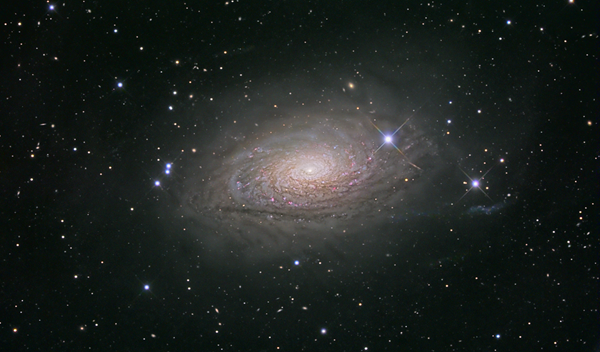The brighter of the pair, Alpha (α) Canum Venaticorum, is known by the proper name Cor Caroli. Cor Caroli translates as “Charles’ Heart.” Most authorities agree that the name was coined in 1660 by Sir Charles Scarborough, physician to King Charles II of England. But exactly which Charles’ heart was being memorialized is not well established. Some say the intended honoree was King Charles I of England, who was beheaded in 1649 during the English Civil War. Others say it refers to his son, Charles II, who restored the English monarchy in 1660.
Because Cor Caroli shines at only 3rd magnitude, it does not stand out well to the eye alone. Hunt it down with binoculars and you’ll be looking at the prototype of a special category of spectral type A suns classified as “magnetic stars.” Studies show that it is abundant in mercury and silicon, as well as some rare elements, like europium.
A 6th-magnitude, type F yellow-white companion orbits Cor Caroli, separated by 19″. That’s likely too close to resolve through most handheld binoculars, but I can just detect both through my tripod-mounted 16x70s. Give it a try and let me know how you make out.
Due east of Cor Caroli are 15 and 17 Canum Venaticorum. Together, they make an easy double star to admire through low-power binoculars. Both appear almost identical, with the eastern star (15 Canum Venaticorum) shining at magnitude 6.3, while
17 Canum Venaticorum glows at magnitude 6. Both glow pure white. In reality, however, their alliance is just circumstantial. Estimates place 17 Canum Venaticorum at 202 light-years from us, while 15 Canum Venaticorum is at 1,144 light-years.
Turning our attention to the constellation’s Beta (β) star, we come to Chara, the Greek word for “joy.” Shining only at magnitude 4.3, Chara is spectral type G0, a yellow dwarf main sequence star that is often referred to as a solar analogue. It’s only 100 kelvins hotter, 18 percent more luminous, and 4 percent larger than our Sun. It’s also believed to be about 2.5 billion years older. In other words, when we look at Chara, we are essentially looking at our future Sun from a distance of just over 27 light-years.
Cor Caroli and Chara are separated in our sky by 5°, close enough to squeeze into the same 10x binocular field. Place them both in view on either side of the field. Just south of an imaginary line connecting them, you’ll see 6th-magnitude 10 Canum Venaticorum, another type G0 star. But to the line’s north, about 3° due east of Chara, you might also spot a small, faint blur of grayish light. That’s the 8th-magnitude spiral galaxy M94. Nicknamed the Cat’s Eye Galaxy or Croc’s Eye Galaxy for its appearance in photographs, M94 is seen nearly face-on from our perspective. As spirals go, it is small, a bit more than half our Milky Way in diameter. Despite its modest size, M94 packs a punch. It is also classified as a starburst galaxy, where internal density waves are compressing interstellar matter into protostars more vigorously than in typical spirals.
Although it strikes me as a little fainter than M94, M63 (the Sunflower Galaxy) is also within reach of 35mm to 50mm binoculars. To find it, place Cor Caroli in the southwestern edge of your binocular field and then glance to the opposite side. You should see four stars set in a distinctive right triangle. M63 is just 1° north of 19 Canum Venaticorum, the star at the triangle’s right angle. Look for a thin sliver of light tilted east-west. Like M94, M63 is classified as an Sb spiral galaxy. The marked difference in appearance is owing to its angle of presentation. While M94 is seen virtually face-on, M63 is tilted at a much narrower angle. Although they are no more than a binocular field apart in our sky, M63 is substantially farther away, some 26.7 million light-years to M94’s 17.3 million light-years. Under a dark sky, you might notice a faint star at the western tip of M63. Although it’s often mistaken for a supernova within M63, that star is just a photobomber from the Milky Way.
Thoughts? Comments? Contact me through my website, philharrington.net. Until next time, remember that two eyes are better than one.










